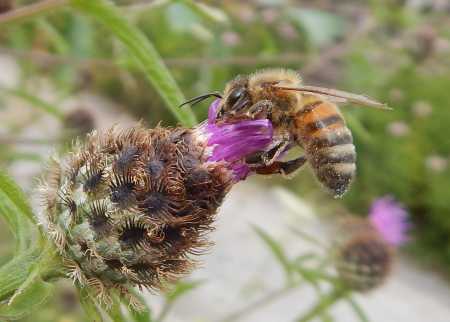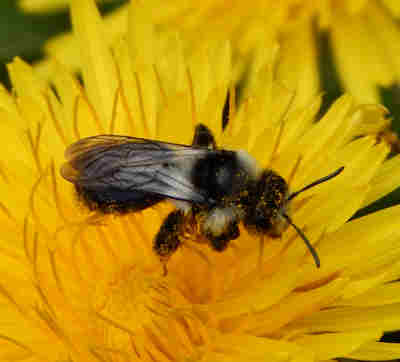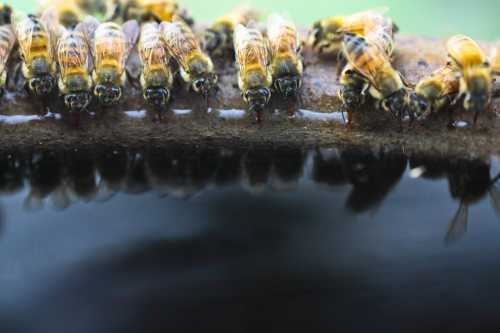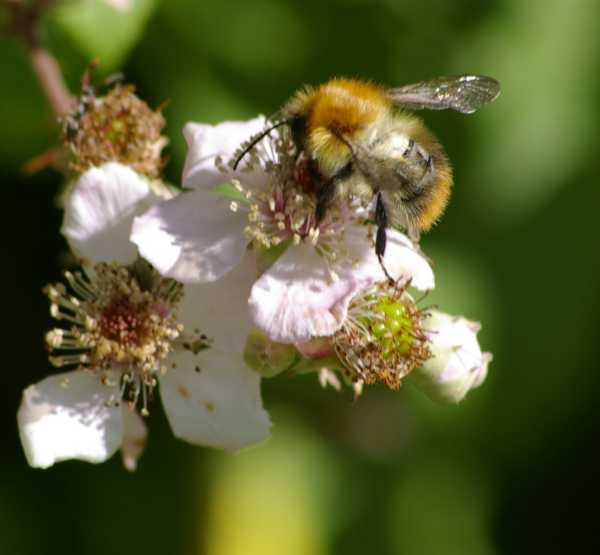How Long Do Bees Live?
Updated: October 2023
"How long do bees live? "
The answer to this question depends on the type of bee referred to, and the role of the bee within the colony.
Comparison Of the Lifespans Of Well-Known Species
The lifespan of bees, can of course, also be affected by extraneous factors such as weather, availability of forage, human intervention, and use of insecticides as well as prevalence of diseases and parasites.
Below is a general comparison of species.
How long do honey bees live?
Honey bees live in sophisticated colonies - they are 'superorganisms' comprising up to 50,000 to 60,000 bees - mostly workers.
Each bee performs a different role in order to help ensure the smooth running and success
of the colony, and the role of a bee, as well as the time of year in which it was born (spring/summer or autumn), is an important factor in the lifespan for worker bees in the colony.
Published studies, papers and books provide varying answers as to the life span of the different bees in a colony, but we do know that queens live the longest, and worker bees born in spring/summer have shorter, busier lives than those born in autumn. However, autumn-born bees must survive the harsher conditions of winter to emerge from the hive the following spring.
In summary:
| Average life span of the honey bee by colony member | |
|---|---|
| Worker | Spring/Summer born: 2 - 6 weeks Autumn born: 20 weeks (Prado et al 2020) |
| Queen | 1 - 2 years on average (Remolina et al 2008) but up to 5 years (Prado et al 2020) |
| Drone | 30 days on average (Czekońska et al 2015) or up to 55 days (Rhodes 2002) |
There are variations, so please read on to learn more...
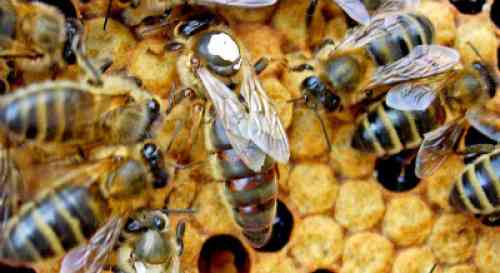 A honey bee queen with workers.
A honey bee queen with workers.Queen Honey Bees
Some beekeepers report queen survival of up to 6 years1.
However some beekeepers actively replace the queen after one or two years, which fits in with the study from Remolina et al2.
That said, all being well, a honey bee queen could live up to 5 years3, as long as she is free from disease. This is much longer than bumble bee queens or the solitary bee species.
However, a queen that is no longer favoured by the colony may be removed by the workers. In such a case, a new queen will be produced, and the old queen replaced. This is called ‘supersedure’.
Workers
Workers raised during the spring or summer months may live for 2 to 6 weeks3. Their lives are especially busy, with lots of hungry larvae to feed, and honeycomb to be produced.
This is when the colony is at its most productive, with workers busy collecting nectar and pollen for feeding the colony. Workers raised in the autumn have no brood to care for, since the queen stops producing eggs.
These workers, together with the queen, comprise the remains of the colony for the year (part of the colony may have left in a swarm, in order to form a new colony elsewhere).
They must huddle together around the queen in order to keep warm during the winter, ready to emerge the following year to begin foraging again in the early spring. They may live 20 weeks3.
Drones
The average lifespan of drones is about 30 days4 although they may live for 555 days.
Note, that upon mating with the queen, drones die immediately.
How long do bumble bees live?
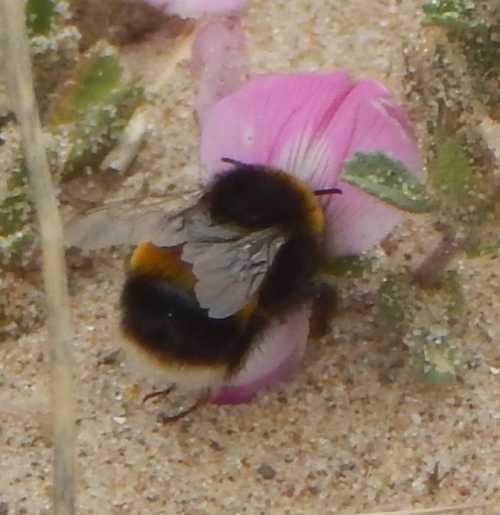 Bumble bee on restharrow.
Bumble bee on restharrow.Information
about the lifespan of bumble bees tends to vary according to the study and species, as well as the environment.
In the tropics, where bumble bee colonies
may thrive for longer, the lifecycles and lifespan of colony members may be quite different from colonies in Northern Europe.
There are anomalies too. For example, even in the UK, change in climate is believed to be having an impact on bumble bees, with some colonies continuing to be active during the winter in the south of England.
However, typically…
Queen bumble bees
All in all, providing a queen is successful and is not harmed by disease, pesticide or predators, she may live for about a year - part of this time being spent overwintering.
New bumble bee queens emerge during the late summer or early autumn. After mating and feeding to store fat reserves on their bodies for the winter, they will then hibernate (or diapause). During early spring the following year, the new queens emerge to establish new colonies of their own.
Worker bumble bees
Accounts of how long bumble bees live, do vary between species and studies.
For example, Bombus terricola workers were observed to live 13.2 days on average to around 2 weeks, but in other studies, workers were observed to live for up to 41.3 days – about 6 weeks7.
It is believed that workers engaged in nest duties live longer than bumble bee workers whose main duty is foraging.
It is not unusual to find a bedraggled looking bumble bee needing to sleep / rest and revive itself, having been caught in a rain shower.
These bumble bees are also of course, more prone to predator attack, and are also exposed to varying weather conditions.
Male bumble bees
I have not read any information giving the lifespan of bumble bee males.
However, they, along with the new queens are the last to emerge from the colony. They typically live only for a few weeks.
You may wish to read more on my page about bumble bees.
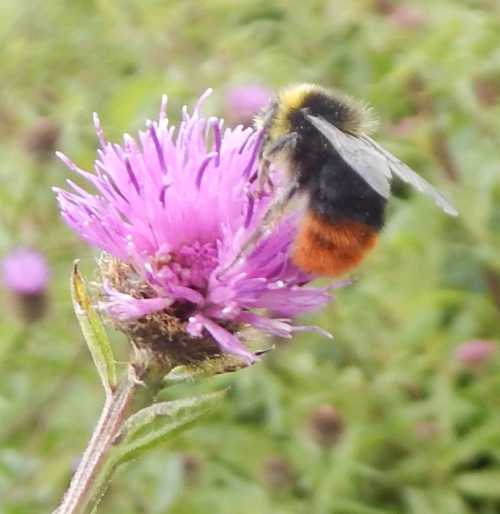 Red-tailed bumble bee male on knapweed.
Red-tailed bumble bee male on knapweed.
How long do solitary bees live?
Given the many species of solitary bees, it's difficult to provide a single summary.
In addition, the
bee life cycle has 4 key stages, but even the length of time between
those stages differs, depending on species.
It also depends whether or not we include the larval stage within our calculation of the total lifespan. Some species may overwinter as adults, others as larvae.
For instance, according to the book, The Bees In Your Backyard, the larvae of some species emerge at different times, even waiting more than a year before emerging ('bet-hedging').
This is the case with bees of the Habropoda genus. Not all larvae of Habropoda emerge from the nest in the same year. Some of the larvae remain behind in the nest for up to 2 years, others from 7 to 10 years!
It's thought that hedge-betting behaviour in bees is especially beneficial in challenging conditions such as the desert. This is the case with the desert bee, Perdita portalis6:
".....according to new research by Cornell entomologist Bryan N. Danforth, not all the viable larvae emerge in any one year of diapause, and their "coming out" is triggered by rain.
Writing in the October issue of The Proceedings of the Royal Society of London, Danforth notes that by spreading reproduction over several years, desert bees can keep catastrophic losses of their kin to a minimum in very bad drought years."
If only some of the bees emerge the following year (whilst others remain behind), then not all of the bees will perish if there are insufficient flowers upon which to forage.
For a few examples and links to more information on specific species, take a look at my pages about the different types of bees, and see below for further information.
References
1. UK beekeeper, Roger Patterson reports seeing queens of Apis mellifera mellifera continuing to rear productive colonies at 6 years old: http://dave-cushman.net/bee/supersedure.html
2. Remolina SC, Hughes KA. Evolution and mechanisms of long life and high fertility in queen honey bees. Age (Dordr). 2008;30(2-3):177-185. doi:10.1007/s11357-008-9061-4.
3. Prado A, Requier F, Crauser D, Le Conte Y, Bretagnolle V, Alaux C. Honeybee lifespan: the critical role of pre-foraging stage. R Soc Open Sci. 2020 Nov 11;7(11):200998. doi: 10.1098/rsos.200998. PMID: 33391795; PMCID: PMC7735337.
4. Czekońska, K., Chuda-Mickiewicz, B. & Samborski, J. Quality of honeybee drones reared in colonies with limited and unlimited access to pollen. Apidologie 46, 1–9 (2015). https://doi.org/10.1007/s13592-014-0296-z
5. Drone honey bees – rearing and maintenance DAI/112, Revised March 2002 J. Rhodes Livestock Officer, Apiary Products, Tamworth, NSW Agriculture.
6. Cornell University: "Emergence dynamics and bet hedging in a desert bee, Perdita portalis".
7. Bumblebees, Their Behaviour and Ecology. Goulson, D. (2003); Oxford University Press, ISBN 0-19-852607-5.
